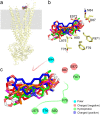Different structures of berberine and five other protoberberine alkaloids that affect P-glycoprotein-mediated efflux capacity
- PMID: 30442987
- PMCID: PMC6318324
- DOI: 10.1038/s41401-018-0183-7
Different structures of berberine and five other protoberberine alkaloids that affect P-glycoprotein-mediated efflux capacity
Abstract
Berberine, berberrubine, thalifendine, demethyleneberberine, jatrorrhizine, and columbamine are six natural protoberberine alkaloid (PA) compounds that display extensive pharmacological properties and share the same protoberberine molecular skeleton with only slight substitution differences. The oral delivery of most PAs is hindered by their poor bioavailability, which is largely caused by P-glycoprotein (P-gp)-mediated drug efflux. Meanwhile, P-gp undergoes large-scale conformational changes (from an inward-facing to an outward-facing state) when transporting substrates, and these changes might strongly affect the P-gp-binding specificity. To confirm whether these six compounds are substrates of P-gp, to investigate the differences in efflux capacity caused by their trivial structural differences and to reveal the key to increasing their binding affinity to P-gp, we conducted a series of in vivo, in vitro, and in silico assays. Here, we first confirmed that all six compounds were substrates of P-gp by comparing the drug concentrations in wild-type and P-gp-knockout mice in vivo. The efflux capacity (net efflux) ranked as berberrubine > berberine > columbamine ~ jatrorrhizine > thalifendine > demethyleneberberine based on in vitro transport studies in Caco-2 monolayers. Using molecular dynamics simulation and molecular docking techniques, we determined the transport pathways of the six compounds and their binding affinities to P-gp. The results suggested that at the early binding stage, different hydrophobic and electrostatic interactions collectively differentiate the binding affinities of the compounds to P-gp, whereas electrostatic interactions are the main determinant at the late release stage. In addition to hydrophobic interactions, hydrogen bonds play an important role in discriminating the binding affinities.
Keywords: P-glycoprotein; berberine; binding affinity; efflux; protoberberine alkaloid.
Conflict of interest statement
The authors declare no competing interests.
Figures







Similar articles
-
Berberine analogue IMB-Y53 improves glucose-lowering efficacy by averting cellular efflux especially P-glycoprotein efflux.Metabolism. 2013 Mar;62(3):446-56. doi: 10.1016/j.metabol.2012.09.009. Epub 2012 Oct 15. Metabolism. 2013. PMID: 23079743
-
Homology Modeling of the Human P-glycoprotein (ABCB1) and Insights into Ligand Binding through Molecular Docking Studies.Int J Mol Sci. 2020 Jun 5;21(11):4058. doi: 10.3390/ijms21114058. Int J Mol Sci. 2020. PMID: 32517082 Free PMC article.
-
Effects of the chemosensitizer verapamil on P-glycoprotein substrate efflux in rainbow trout hepatocytes.Comp Biochem Physiol C Toxicol Pharmacol. 2024 Jan;275:109763. doi: 10.1016/j.cbpc.2023.109763. Epub 2023 Oct 10. Comp Biochem Physiol C Toxicol Pharmacol. 2024. PMID: 37820937
-
P-glycoprotein recognition of substrates and circumvention through rational drug design.Mol Pharm. 2006 Jan-Feb;3(1):3-25. doi: 10.1021/mp0500871. Mol Pharm. 2006. PMID: 16686365 Review.
-
Approaching strategy to increase the oral bioavailability of berberine, a quaternary ammonium isoquinoline alkaloid: part 2. development of oral dosage formulations.Expert Opin Drug Metab Toxicol. 2023 Mar;19(3):139-148. doi: 10.1080/17425255.2023.2203858. Epub 2023 Apr 20. Expert Opin Drug Metab Toxicol. 2023. PMID: 37060323 Review.
Cited by
-
Neuroprotective effect and preparation methods of berberine.Front Pharmacol. 2024 Sep 6;15:1429050. doi: 10.3389/fphar.2024.1429050. eCollection 2024. Front Pharmacol. 2024. PMID: 39309003 Free PMC article. Review.
-
Berberine-microbiota interplay: orchestrating gut health through modulation of the gut microbiota and metabolic transformation into bioactive metabolites.Front Pharmacol. 2023 Dec 7;14:1281090. doi: 10.3389/fphar.2023.1281090. eCollection 2023. Front Pharmacol. 2023. PMID: 38130410 Free PMC article.
-
Pharmacokinetics and Pharmacological Activities of Berberine in Diabetes Mellitus Treatment.Evid Based Complement Alternat Med. 2021 Aug 21;2021:9987097. doi: 10.1155/2021/9987097. eCollection 2021. Evid Based Complement Alternat Med. 2021. PMID: 34471420 Free PMC article. Review.
-
Rhizoma coptidis as a Potential Treatment Agent for Type 2 Diabetes Mellitus and the Underlying Mechanisms: A Review.Front Pharmacol. 2019 Jul 22;10:805. doi: 10.3389/fphar.2019.00805. eCollection 2019. Front Pharmacol. 2019. PMID: 31396083 Free PMC article. Review.
-
Co-Delivery of Berberine Chloride and Tariquidar in Nanoliposomes Enhanced Intracellular Berberine Chloride in a Doxorubicin-Resistant K562 Cell Line Due to P-gp Overexpression.Pharmaceutics. 2021 Feb 26;13(3):306. doi: 10.3390/pharmaceutics13030306. Pharmaceutics. 2021. PMID: 33652886 Free PMC article.
References
-
- Preininger V. Chemotaxonomy of papaveraceae and fumariaceae. In: Arnold B, editor. The alkaloids: chemistry and pharmacology. vol. 29. New York: Harcourt Brace Jovanovich; 1986. p. 1–98.
-
- Bandyopadhyay S, Patra PH, Mahanti A, Mondal DK, Dandapat P, Bandyopadhyay S, et al. Potential antibacterial activity of berberine against multi drug resistant enterovirulent Escherichia coli isolated from yaks (Poephagus grunniens) with haemorrhagic diarrhoea. Asian Pacific J Trop Med. 2013;6:315–9. - PubMed
MeSH terms
Substances
LinkOut - more resources
Full Text Sources
Miscellaneous

